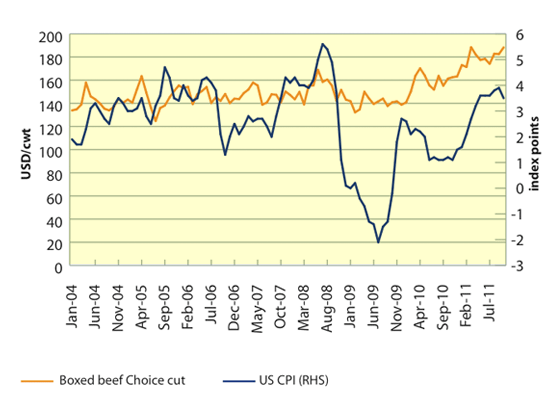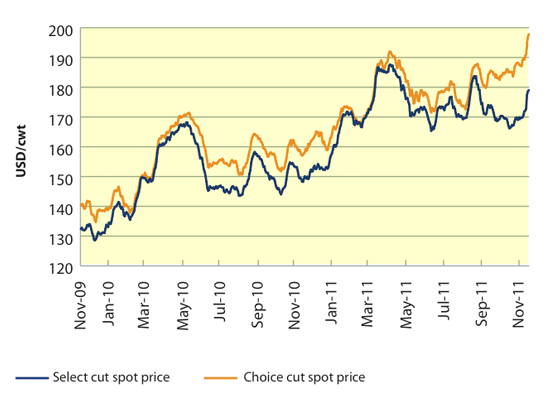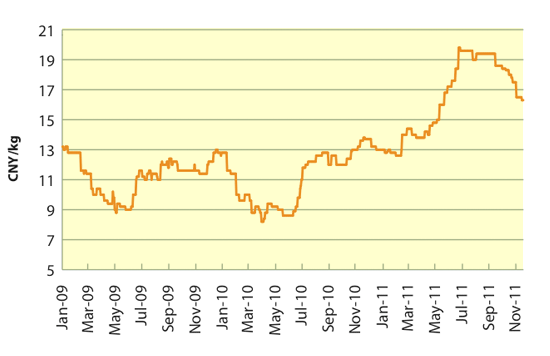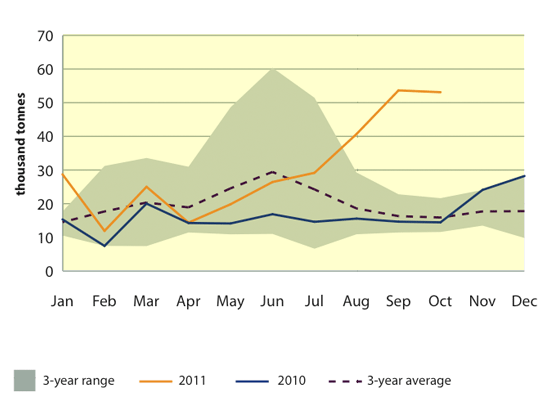



Rabobank Outlook 2012 - Demand To Remain Strong
US cattle prices are expected to continue their strong performance into 2012, whilst hog prices are expected to flatten as supply increases, according to Rabobank's Outlook 2012 - Agri Commodity Markets Research.Rabobank expects US cattle prices to continue their strong performance in 2012 albeit with a brief plateau in Q1 as record feedlot inventories reach the market. However, tight feeder supply should bias price upwards from spring onward.
Lean hog prices are expected to flatten in 2012 as US and global supply increases but upside risks remain with strong Asian demand and risk of disease in the Chinese domestic herd. Strong demand from emerging-market economies is expected to provide robust support for US livestock markets in 2012.
Live cattle
US live cattle prices are expected to fall in Q1 2012 from their November 2011 highs as record numbers of cattle on feed outstrip demand in the near term. A record drought in the southern US has left producers with a severe shortage of pasture and resulted in higher placements of feeder cattle this year, at lighter weights than normal.
The September placement of cattle under 600 pounds was 685,000 head, compared with 510,000 head in August 2010—a 34 per cent increase—while in October 2011, the year- on-year spread narrowed to an 11 per cent increase. We anticipate the lower weights and increase in placements will result in a large amount of live cattle being brought to market in the early months of 2012 as cattle placed into feedlots in July, August and September of 2011 work their way through the system.
Tight supplies of feeder cattle mean that live cattle prices in Q2 2012 are expected to rise in the US, further squeezing packer margins. Given the poor calving numbers in 2011, the shortage of feeder cattle is not expected to be alleviated in 2012. Packers have incurred negative margins on domestically sold beef in 2011 but have been able to at least partially recoup losses on strong Asian exports at profitable levels.
US beef exports jumped strongly in 2011, up over 25 per cent YOY and up 9.12 per cent on the five-year average. Our forecast of a weakening US dollar and relatively strong Australian and Brazilian currencies, two of the US’s major competitors in the beef export market, drive our forecast of improving US beef demand from foreign markets. However, this will also force US packers to reduce imports of foreign beef.
With the anticipated relaxation of import restrictions by Japan and the recent ratification of the US–Korea Free Trade Agreement, we see both improved market access and export demand providing strong support for US beef prices in 2012. However, this upside will be somewhat tempered if economic conditions deteriorate much further and emerging-market economy growth slows.
These restrictions currently require US beef cattle to be 20 months of age or younger at the time of slaughter, but under new proposals, the maximum import age is likely to be increased to 30 months. The catalyst for the relaxation of restrictions has been the decline in Japan’s domestic beef production following the tsunami in March 2011 and resulting radioactive contamination in the Japanese agri complex. With imports of 351 million pounds, Japan was the third- largest export market for US beef in 2010.
However, their imports in 2010 were 61.7 per cent below where they were in 2003 at 918 million pounds, before restrictions were imposed. Japan’s relaxation of the age restriction on US beef opens the market to heavier carcass weights. If the yen continues its strong performance against the US dollar, we expect there to be strong upside potential for US beef exports into Japan in 2012.
We expect to see the beef cut market continue to exhibit a large spread between Choice and Select cuts in 2012 as seen in the latter half of 2011. The catalyst for this spread movement has been the entry of Walmart into the Choice beef market. Walmart has long been a retailer of Select cuts, the lowest of three USDA grades of beef at the retail level in the US.
However, in an effort to increase sales and attract a higher value customer, the world’s largest retailer has added Choice cuts, the midlevel retail cut, to their meat aisle. This move has increased the spread between Choice and Select cuts to a full USD 19/cwt from a pre-Walmart entry spread of a mere USD 3/cwt. Over 50 per cent of Walmart’s 260 billion dollar income came from grocery sales in 2010. Given Walmart’s market share, packers have been bidding up the price of live cattle, despite negative domestic margins, in an effort to capture long-term business from the new player in the Choice cut space.
We see the entry of such a retailer into the Choice cut market as being supportive of prices for 2012 and expect the spread between wholesale boxed Choice cuts and wholesale boxed Select cuts to remain stable at current levels.
Figure 3.28: US beef prices and inflation, Jan 2004-Jul 2011

Figure 3.29: US boxed beef cutout value 600 lbs-900 lbs spread, Nov 2009-Nov 2011

Lean hogs
Momentum in the US lean hog market is expected to wane in 2012 as producers increase farrowing to meet demand and Chinese import growth slows. This is coming off the back of strong bullish momentum in the US lean hog market in 2011.
US herd inventories in 2011 rose by 2.5 per cent in Q3 from the traditional seasonal low at the end of Q1; this is compared with the Q3 2010 rise of 1.6 per cent. Just as the cattle market benefited from a low US dollar and high export demand, so too has the pork industry. Strong export demand in 2011 has helped maintain higher domestic prices, a situation that will likely continue with a weak US dollar in 2012.
Pork producers and processors have been challenged with slowing margin growth due to the upward shift in corn prices. CBOT corn prices averaged 61 per cent higher in 2011 than in 2010. As a percentage of total feed cost in the raising of US lean hogs, corn has risen from 49.6 per cent to 54.6 per cent due to both the higher corn cost and the 11.8 per cent fall in the price of soymeal. Using a 3:1 feed conversion ratio and assuming a 75 per cent corn feed mix, the cost of adding one pound to a hog under the current April 2012 live hog crush is USD 0.42/pound.
While US breeding stocks increased 1.3 per cent in November, eventual year-on-year expansion is uncertain due to the relatively high price of corn. Current lean hog packer margins for December 2011-April 2012 indicate a profit of USD 8.58/cwt, a USD 10.27/cwt turnaround from the same crush last year. In the December-April crush, corn accounts for 55 per cent of total feed cost, a rise of 5 per cent from the same crush 12 months ago.
November 2010 saw producers working with a corn cost of USD 60.01/head, which rose to USD 67.14/head in November 2011, though the increase in the price of lean hogs more than offset this. This upward movement in the lean hog market has been driven, to a large extent, by strong export demand. The January to September export figures released by the USDA report pork exports at 1.68 million tonnes. This equals a 288 thousand tonne increase year-on-year or a 20.6 per cent increase in volume and a 40.5 per cent increase in value.
There is a risk of weaker pork exports into China in 2012 as domestic producers recover from disease outbreaks and scale up production. This increase in production has already been seen to a degree, as Chinese producers reacted to a 139 per cent price rise in the five months to July 2011.
There was widespread liquidation of the Chinese domestic hog herd in 2011 due to disease and this resulted in a larger-than-expected shortfall in domestic production. In the wake of this shortage, imports of US pork in China rose 67.5 per cent in the first three quarters of 2011, a figure that rises to 376 per cent if Taiwan and Hong Kong numbers are excluded. Unsurprisingly, the sharp increase in prices has since resulted in increased herd-building and increases in animals brought to market, resulting in a fall from the June high of CNY 19.8/pound.
With pork considered to be of national strategic importance to China, the government has initiated large campaigns to reduce the outbreaks of foot-and-mouth disease and is simultaneously seeking to modernise the production chain, with the ultimate goal of reaching self-sufficiency.
Japan, the largest export market for US pork, increased demand by 14 per cent for the period of January to October compared to the same period in 2010. The increase in demand was driven by the appreciation of the yen against the US dollar. Pork export demand is increasingly exposed to currency fluctuations as the Bank of Japan continues to intervene in the foreign exchange market and states that it will continue to do so in order to support domestic exports on a lower yen.
Figure 3.30: Chinese pork spot prices, Jan 2009-Nov 2011

Figure 3.31: China’s pork imports volume, Jan 2010-Oct 2011



